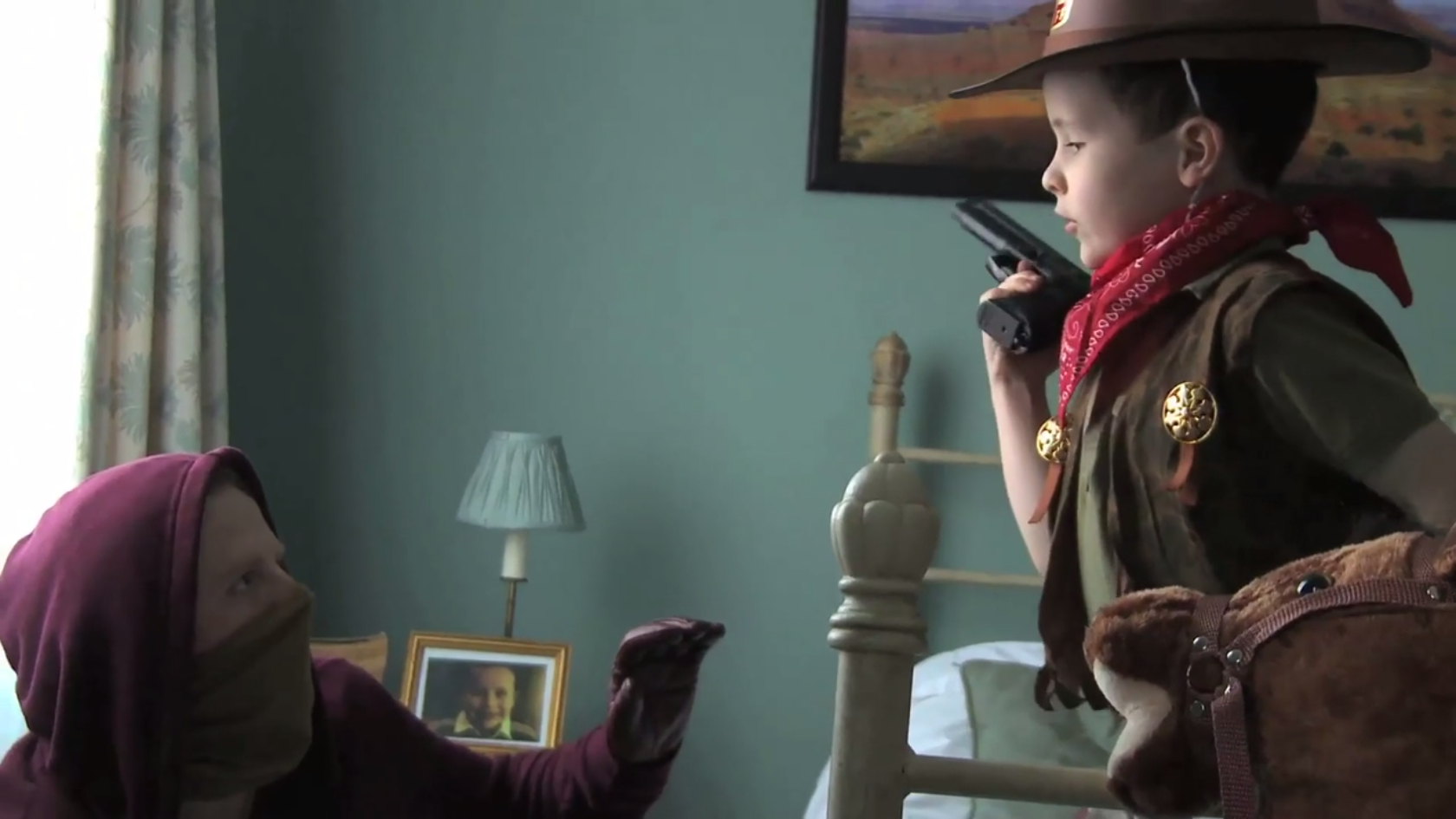Will Maloney’s Cowboy’s and Dissidents is the story of Roy, a young Irishman assigned to avenge the death of his father by killing the policeman responsible by association for his death. Roy breaks into the policeman’s home and manages to sneak upstairs into a bedroom before being seen by the policeman’s wife. Roy places his gun on the bed and prays. While deep in prayer, Roy hears the click of a gun behind him. He turns and discovers Andy, a young boy dressed in a cowboy costume, pointing the gun he had placed on the bed directly at him. Andy is entirely unaware that the gun he is holding and pointing at Roy is real. What follows is a suspenseful sequence of events with greater implications.
***SPOILER WARNING***
During the opening sequence, a detective makes a few statements that perfectly encapsulate an underlying theme within the film. “Now I want you to look at each of these men carefully,” the detective says. “They are all bad men. But don’t worry, they can’t see you.” The men in question have been deemed “bad”, but as Maloney illustrates to us, Roy is not necessarily a bad man — at least not yet. From the film’s onset, Roy appears both hesitant and scared; while he wants to avenge his father, he is not entirely comfortable taking another’s life. We can see his reluctance and it becomes clear this is the first time he’s attempted to take the life of another man. Maloney tells us Cowboys and Dissidents is a story about the changing face of Northern Ireland and how far one man is willing to go in the name of revenge. “I wanted to challenge the divides that continue to fragment Northern Ireland by exploring an unlikely relationship,” he said. “Cowboys is about the value of tradition and the extremes to which it can take us.“
During the beginning of the film, Andy seems to view the world in terms of black and white. To him, cowboys symbolize “good” and Indians symbolize “bad.” Andy confronts Roy as an Indian, who ultimately convinces Andy that he is, in fact, a cowboy (good) merely posing as an Indian (bad). While this functions narratively in the sense that it allows Roy to regain control of his gun — and, more importantly, getting the gun out of the hands of a child and preventing a painfully tragic incident from taking place — what it does is reveal something greater about the flawed and limited dichotomy of “good” and “bad.”
Costumes and masks play an important role in this film: we have Roy’s iconic maroon hood and green mask, a young boy in the back seat of a car wears a donkey mask, Andy sports a cowboy costume, and there’s the impression of a policeman’s uniform. While costumes have the practical effect of hiding the identity of the person behind the mask, they also have the effect of disguising that person from themselves. When Roy puts on his hood and mask, he assumes an identity that is not really his own — one that even he himself has trouble holding onto. Throughout the film, he fidgets with his hood and mask, trying to be certain his identity is hidden, but also in attempts to be more comfortable. And he is most certainly not comfortable.
In many ways, the idea of masks plays into the idea of the dismantling of the dichotomy between “good” and the “bad” mentioned above. Andy innocently sees people as being either “good” or “bad” according to their costumes, but then again, so does Roy — and so does the police officer we see in the beginning. Roy perceives policemen (and thus, police uniforms) as being equatable to “bad” because of the associations he has with them being responsible for his father’s death. In Roy’s mind, because one policeman killed his father, all policeman are responsible. But when he is confronted with the humanity of the man behind the uniform — and in effect, the costume — his feelings change. In a sense, the absurdity of associations with real life costumes is much more visible when presented on a child, and the exposition of the humanity revealed by the child effectively convinces Roy to leave and not follow through with his assignment.
In the end, we return to the lineup of men and the policeman asking Andy which of the bad men he saw in his house. However, because of the relationship Roy establishes with Andy and the signal agreed upon, Andy does not expose Roy as the perpetrator, but instead says that he himself was the one in the room. This revelation in many ways brings us to an interesting conclusion: Andy, with all his innocence, demonstrates to us a greater wisdom. He recognizes that it’s not that simple to designate somebody as “bad.” In the end, it’s interesting to see Roy in a line-up, without his costume and in the utmost stressful conditions, have confidence in himself not just because of the confidence he had in the relationship established with Andy, but because of the wisdom he gained through the experience.

 Jeanette Bonds
Jeanette Bonds